-
- Sarawak Map
|
-
- Map of Southeast Asia
|
- Indonesia
-
-
|
- latest picture:
November 16, 2017
|
-
-

|
-
-

|
-
-

|
-
094
Liliana is standing at the little gate that marks
- the beginning of the jungle trail to Kali waterfall.
- It turns off at the village of Kali 7½
mi [12km]
- south of Manado (coord.
1.39518/124.84216) …..
|
-
095
….. shortly after we are surrounded by
- ferns, trees, palms,
giant leaves and creeping
- plants, which lushness and variety
fascinates
- us at every step during approx. ½ hour …..
|
-
096
….. red-green leaves are common
- and sticking out brightly from
the green
- surroundings
|
-
|
-
-

|
-
-

|
-
-

|
- Following the more or less overgrown jungle track we venture
deeper into the forest and discover pretty flowers and a rock,
- covered with moss that someone gave it a face
|
-
097 Pagoda Flower (Clerodendrum
- Paniculatum)
|
-
098
|
-
099
|
-
|
-
-

|
-

|
-
-

|
- The gorgeous vegetation continues to please us all the way to the
waterfall: Once it is a colored leaf, once just shrub
|
-
100
|
-
101
|
-
102
|
-
|
-
-

|
-

|
-
-

|
-
103
A creeping plant clings to a strong
- palm tree that heads
straight for the sun
|
-
104
Liliana is enshrouded by the dense
- tropical forest vegetation.
This is what she
- most likes to do: To explore untouched nature
|
-
105
A young fern in its ultimate beauty
|
-
|
-
-
-
-

|
-
-

|
-
-
-
-

|
-
106
A butterfly that breaks the lush tropical
- green with its
bright orange color
|
-
107
On the nature trail we discover all kind
- of interesting
flowers and leaves. This red
- flower is a single specimen, probably
- belonging to the ginger family
|
-
108
The not anymore maintained jungle
- path where fallen trees lie
across, adds to
- the adventurous taste. One of the gorgeous
- flowers
we notice is a yellow ginger blossom
|
-
|
-
-

|
-
-

|
-
-

|
-
109 After about a 20 minutes’ walk, the
- rushing
of the waterfall announces itself. And
- then, we are standing in
front of the Kali water-
- fall in its fairytale surrounding of moos and
- leaves that cover everything in its surroundings
|
-
110 Actually there are two waterfalls that
- captivate us: The bigger one might be about
- 200 ft. [60m], the
smaller one 65 ft. [20m]
|
-
111 Liliana is standing on
the little bridge in
- front of the waterfall. She doesn't mind to be
- soaked by the spray, too beautiful is the
- experience to have this
romantic place
- completely to ourselves
|
-
|
-
-
-
-

|
-
-

|
-
-
-
-

|
-
112
In Rap Rap in Airmadidi are ancient
- “Waruga” stone sarcophagi.
The Minahasans
- of North Sulawesi laid to rest their dead in a
- fetus
position looking North in the belief that
- their ancestors came from
North …..
|
-
113
….. a tombstone with an owl engraving
|
-
114
On their way home school kids
- are passing by at the “Waruga”
park in
- Airmadidi. As always our LandCruiser
- stirs up their
curiosity
|
-
|
-
-
-
-

|
-
-

|
-
-
-
-
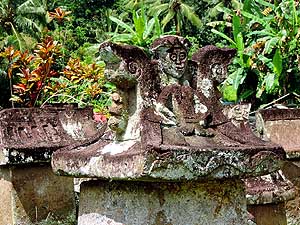
|
-
115
The bigger “Waruga” stone sarcophagus
- park in Sawangan belongs
to the UNESCO
- World Heritage Sites. Here the engravings
- are more
elaborated than in Rap Rap …..
|
-
116
….. a single head stands out
- from all the others …..
|
-
117
….. but also this tombstone deserves a
- closer look. Most date
from mid-19th century,
- but there also previous ones (1769)
|
-
|
-
-

|
-

|
-
-

|
- The Gardenia Hotel in Tomohon has a beautiful large scale flower
garden. We admire especially:
|
-
118
Orchids that look especially
- attractive in their natural
surrounding
|
-
119
The pink flowers with the name
- Medinilla (Medinilla
astronioides)
|
-
120
The exotic palm tree with its red seeds
|
-
|
-
-
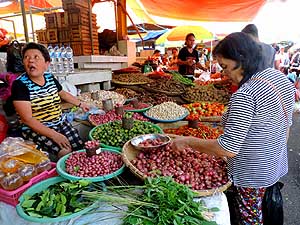
|
-
-

|
-
-

|
-
121 Onions, garlic, chili, tomatoes, lemon,
- ginger, potatoes and a lot more is on display
- at this market stall
in Tomohon
|
-
122 Cooked food and sweets are
- stored behind fly
protecting glass
|
-
123 Especially
eye-catching are the huge piles
- of chili peppers. Practically no
food is served
- in Indonesia without these peppers
|
-
|
-
-

|
-
-

|
-
-

|
-
124 Fish is an important food source in
Indo-
- nesia. Here it is sold dried on bamboo frames
|
-
125 Skipjack tuna (Katsuwonus pelamis)
- is
a Minahasan delicacy
|
-
126 Smoked skipjack tuna
(in Minahasan
- language: Cakalang fufu), clipped
- on a bamboo frame
|
-
|
-
-

|
-
-

|
-
-

|
- When we reach the traditional meat section at the Tomohon market –
which is also mentioned accordingly in “Lonely Planet's” Indonesia
guidebook –
- we are confronted with shockingly macabre images. We
have debated extensively if we shall show them on our website or not
but decided to do it,
- because it shows the brutal reality of a
different culture and attitude towards animals
|
-
127 A freshly slaughtered pig is dismembered
|
-
128 Two flame-roasted cats
|
-
129 At the dogs corner it
definitely turns our
- stomach: On the table lie dozens of dead animals.
- Nearby are new victims in cages still living. They
- are
caught with a sling, beaten to death with a
- bludgeon and roasted
over an open fire
|
-
|
-
-
-

|
-
-

|
-
-

|
-
130 Also snakes – here a python – belong
- to the
local diet: They are sold in pieces
|
-
131 A
street vendor is trying to sell us crayfish
|
-
132 A couple of chicken
are already plucked.
- Additional supplies are waiting crammed into
cages
|
-
|
-
-
-
-

|
-
-

|
-
-
-
-

|
-
133
Bush rats are skewered
- and sold flame-roasted
|
-
134
Nothing is spared: Even lizards
- are killed for food
|
-
135
Bats are also sold as meat. The terrified
- expression on their
faces is testimony of their
- agony. The wings are sold separately
|
-
|
-
-

|
-
-

|
-
-

|
-
136 We are gazing from the rim of the
- “Mahawu”
crater in the volcano region of
- Tomohon towards the 5'184 ft.
[1'580m] high
- “Gunung Lokon”, which is ascendable too
|
-
137 Chinese tourists swarm the viewing
- platform
at the “Mahawu” volcano
|
-
138 The “Mahawu” crater is
590 ft. [180m]
- wide and 460 ft. [140m] deep
|
-
|
-
-
-

|
-
-

|
-
-

|
-
139 From the mountain road leading to
- the
“Mahawu” volcano more cloud free
- volcanoes are visible on a clear
day
|
-
140 The
panorama from the “Mahawu”
- volcano is reaching from the scattered
- highland town of Tomohon …..
|
-
141 ….. to the big
“Tondano” Lake
- where there is a road all around
|
-
|
-
-
-
-

|
-
-

|
-
-
-
-

|
-
142
The mountain climate and the fertile
- volcano soil of the Minahasa Highland
- benefit agriculture
|
-
143
Handworked vegetable fields with
- cabbage, onions, carrots,
chili on the
- steep slopes of the Minahasa Highland
|
-
144
On our way back from our tour to the
- “Mahawu” volcano we have
a fine view over
- Tomohon and the Minahasa Highland
|
-
|
-
-
-

|
-
-

|
-
-

|
-
145 On top of the hill sits a new tourist
attraction
- at Kumelembuai near Rurukan: “Tintingon Puncak”
- (=hill)
– particularly popular with tourists from
- China who ‘overrun’ the
Highland
|
-
146 “Danau
Linow”, the small sulfurous
- lake that changes its green
- colors with
the light
|
-
147 Giant leaves – taro (Colocasia
esculenta)
- – belong to the tropical vegetation that
- grow around
Lake Linow
|
-
|
-
-

|
-

|
-
-

|
-
148
Detail of the small hidden Chinese temple
- “Watu Sumanti” near
Kayawu in the Tomohon
- region, which once belonged to a cult site …..
|
-
149
….. Michael, German manager of
- the “Mountain View Resort” in Tomohon
- and Emil on the stairs of the
- Chinese Tempel “Watu Sumanti”
…...
|
-
150
….. Owl at the cult site “Watu Sumanti”.
- At full moon elderly
people apparently still
- offer alcohol and cigarettes for the
deceased
|
-
|
-
-
-
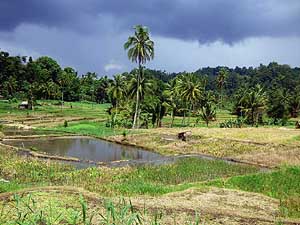
|
-
-

|
-
-
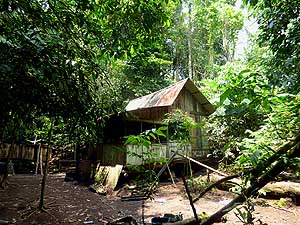
|
-
151 Rice cultivation is an important part of
- the
agriculture of the Minahasa Highland;
- here slightly west of Tomohon
|
-
152 A
hidden primitive bootleg schnaps
- distillery that lays in a forest
- clearing
of Tomohon …..
|
-
153 ….. the modest hut of
the schnaps
- distiller that he uses during his work
|
-
|
-
-

|
-

|
-
-

|
-
154
The white strings of an acacia flower
- (presumably
Archidendron lucyi)
|
-
155
These deep red flowers are a bouquet
- in itself. They belong to
the Achiote shrub
- (Bixa orellana)
|
-
156
These deep hanging angel trumpets
- (Brugmansia versicolor)
originate actually from
- Ecuador and are poisonous. We saw them even
- more often on the island of
Réunion
(pic #57)
|
-
|
-
-
-

|
-
-

|
-
-

|
-
157 Scenic Lake Tondano is the largest lake in
- North Sulawesi. It lies ca. 20 mi [36km] south-
- east of Manado and 1'970 ft. [600m] above sea
|
-
158 Carpets
of water hyacinths (Eichhornia)
- cover the shore of Lake Tondano
- or form floating islets
|
-
159
Fish farming is popular on the shore of
- Lake Tondano. Bamboo
poles and the huts
- of the fish farmers dominate the view
|
-
|
-
-
-

|
-
-

|
-
-

|
-
160 An
idyllic sight at the shore of Lake Tondano
|
-
161 A
fisherman in full action at Lake
- Tondano. Different kind of fishes
populate
- the lake and are being hatched
|
-
162 Dozens of ducks splash
about in puddles
- in the south of Lake Tondano. They are not wild
- but
belong to a farmer who watches over them
|
-
|
-
-
-

|
-
-

|
-
-

|
-
163 The bark of the cinnamon tree
- (Cinnamomum
verum), spread out to
- dry in the sun, scents already from far
|
-
164 One
of the pretty traditional wooden
- houses on stilts on Lake Tondano
|
-
165 Like rice, cinnamon
and chili also
- corncobs are spread out to dry in the sun
|
-
|
-
-

|
-
-

|
-
-

|
-
166
How big might the fern be? Bigger
- than 5 ft. 7½ in. [1.71m] anyhow,
- because this is Emil’s size
|
-
167
A bundle of fruits of a
- toddy palm tree (Caryota urens)
- is hanging heavily from a branch
|
-
168
With its shiny white, this delicate
- flower contrasts beautifully with the
- green of creeping leaves
|
-
|
-
-
-

|
-
-

|
-
-

|
-
169 After its rescue, the rhinoceros
- beetle (Xylotrupes gideon) is clinging
- upside down to a twig
|
-
170 The
Amboina box turtle (Cuora
- amboinensis) lives in a water basin
- of the “Mountain View Resort” in
- Tomohon. But it shows itself rarely
|
-
171 A flying black Atlas
beetle
- (Chalcosoma atlas), also belonging
- to the rhinoceros beetle species,
- takes a rest on a plant
|
-
|
-
-
-
-
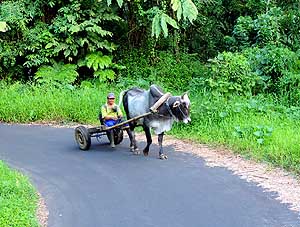
|
-
-

|
-
-
-
-

|
-
172
Every evening at the same time
- this farmer returns with his ox from
- his work in the fields
|
-
173
The papaya fruit is a popular
- tropical fruit. It's said that its seeds help
- also against diarrhea, but they taste awfully
|
-
174
A mystical sight when mist engulfs
- the forest. View from our bungalow at the
- “Mountain View Resort” in Tomohon
|
-
|
-
-
-

|
-
-

|
-
-

|
-
175 The gardener and a ‘tame’ reticulated
- python (Python reticulatus) in front of our
- LandCruiser. The approximately 13 ft. [4m]
- long snake lives in a terrarium at the
- “Mountain View Resort” in Tomohon
|
-
176 The
yellow black-naped oriole
- (Oriolus chinensis) lands every morning
- on a tree in front of our bungalow. It
- announces itself with a melodious call
- – a wonderful start into a new day
|
-
177 Liliana is standing
the last time on
- the balcony of our bungalow at the
- “Mountain View Resort” in Tomohon
- where we spent a relaxing time
|
-
|
-
-
-
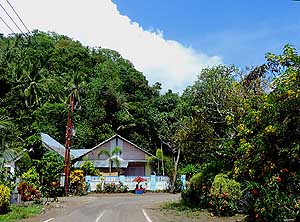
|
-
-

|
-
-

|
-
178 A
neat little house surrounded by tropical
- green and blooming flowers at the coastal village
- of Batu Putih at the entrance of the Tangkoko
- Batuangus Nature Reserve in North Sulawesi
|
-
179 The
tulip tree (Spathodea campanulata)
- with its red flowers and its erected beans are
- actually native to Africa, but
became invasive
- also in e.g. Australasia and
the Caribbean
|
-
180 The little fishing
harbor of the coastal
- village of Batu Putih with its black
sandy shore is
- on a midday nap. In the background the
volcanic
- hills of the Tangkoko National Park
|
-
|
-
-
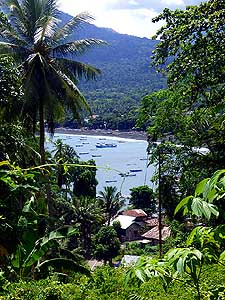
|
-
-

|
-
-

|
-
181
Fishing boats, a black sandy beach at the
- foot of a tropical hill of Mount Tangkoko. This is
- the enjoyable view across the Batu Putih Bay
|
-
182
High palm trees straight as a pole line
- the coast of the Molucca Sea at Batu Putih
|
-
183
View from the palm-fringed shore
- across Batu Putih Bay towards Cap Pulisan
|
-
|
-
-

|
-
-

|
-
-

|
-
184
Our LandCruiser on a discovery tour
- through exuberant tropical green near Batu Putih
|
-
185
A bright dash of color in the tropical
- greenery: A hibiscus flower in full bloom
|
-
186
Who needs a chair if a coconut
- also does the job?
|
-
|
-
-

|
-
-
-
-

|
-
-

|
- At the Tangkoko Batuangus Nature Reserve in North Sulawesi:
|
-
187
Liliana enjoys to watch the Celebes
- crested macaque (Macaca nigra), which live
- at the Tangkoko Batuangus Nature Reserve.
- Their main task is delousing each other
- what they do with great endurance …..
|
-
188
..... this troop consists of 90 animals.
- But there is still a bigger group counting
- 130 members. They are peaceful
- and not yet spoilt by tourists …..
|
-
189
..... the male is watching over its
- harem and is busy fathering new babies
|
-
|
-
-
-
-

|
-
-

|
-
-
-
-

|
- At the Tangkoko Batuangus Nature Reserve in North Sulawesi:
|
-
190
Mushrooms often grow on dead tree trunks
- – one of the many beauties nature produces
|
-
191
It is fascinating, how fast young
- leaves develop and head for the light
|
-
192
Another example of nature’s beauty
|
-
|
-
-

|
-
-

|
-
-

|
- At the Tangkoko Batuangus Nature Reserve in North Sulawesi, the
only recently discovered Gursky’s spectral tarsiers (Tarsius
spectrumgurskyae):
|
-
193
“Who is waking us up again?” two
- adorable tarsiers peek from their tree home.
- These nocturnal primates are a bit smaller (ca. 6")
- [15cm] than the ones we saw mid-January 2011
- on the Island of Bohol in the
Philippines …..
|
-
194
…. tarsiers are one of the world's
- smallest primates. Their huge eyes are the
- most noticeable; they are the size of their brain.
- The smallest – the pygmy tarsier, 4"
[10cm]
- (Tarsius pumilus) – live in
Central Sulawesi
|
-
195
Three cute ochre-bellied hawk
- owls (Ninox ochracea) are sleeping
|
-
|
-
-
-

|
-
-

|
-
-

|
- At the Tangkoko Batuangus Nature Reserve in North Sulawesi:
|
-
196 The Sulawesi dwarf kingfisher (Ceyx fallax)
- is standing out with its shiny red plumage. It is one
- of the 8 kingfisher species in the reserve
|
-
197 The
knobbed hornbill (Aceros cassidix /
- syn. Rhyticeros cassidix) is native to Indonesia.
- The call of this colorful bird sounds like barking
- of dogs, revealing its presence
|
-
198 We also spot the
blue-headed kingfisher
- (Actenoides monachus) on our 5 hour walking
- tour through the reserve. It is also endemic to
- Central and North Sulawesi
|
-
|
-
-
-

|
-
-

|
-
-

|
- Im Tangkoko Batuangus-Naturreservat in Nord-Sulawesi:
|
-
199 “I am here!” The Sulawesi bear cuscus
- (Ailurops ursinus) is looking cheekily down at us.
- Its habitat is in the trees where it is hard to spot.
It
- weighs about 15lb [7kg] and gets about 24"
[60cm]
- long with a tail that has about the same length. It
- remembers us a bit the lemurs in
Madagascar
|
-
200 Off
the beaten track one easily steps
- into a spider net. Here we spot an interesting
- spider specimen, presumably a female
- golden orb weaver (Nephila pilipes)
|
-
201 The two of us between
impressive
- roots of fig trees (Ficus variegata),
- which are widespread in this reserve
|
-
|
-
-
-

|
-
-

|
-
-

|
- At the Tangkoko Batuangus Nature Reserve in North Sulawesi:
|
-
202 A Phytocrene bracteata, about the size of
- a soccer ball, very heavy and very spiky. The fruit
- hangs from a vine and starts obviously to bloom.
- Resembles a wild durian (Durio Wyatt-Smithii)
|
-
203 A
young round-leaf fountain palm,
- also called woka palm (Livistona rotundifolia)
- shines in its fresh green
|
-
204 Nature reclaims
constantly
- and forms bizarre jungle creations.
- Creepers wrap everything
|
-
|
-
-
-

|
-
-

|
-
-

|
-
205 At the ferry terminal of Bitung, 34mi [55km]
- east of Manado, heavily loaded trucks are ready to
- board the ferry
KMP
Portlink VIII. They will be
- neighbors of our LandCruiser, which
will bring us
- in 15h from Sulawesi to Ternate in the Moluccas
|
-
206 As always our LandCruiser is the
- star. This time it is also a welcome pastime
- for the truck drivers during our 7 hours
- waiting time to board
|
-
207 Thunderstorm clouds
hang deeply over the
- port of Bitung when we leave Sulawesi on Novem-
- ber 16th, 2017, and embark for Rupees 2'692'000
- (= US$210) to the island of Ternate on the
- Moluccas. Nevertheless it was a calm journey
|
-
|
-
More websites from the
"Borneo-Sulawesi-Moluccas-Papua" trip:
-
Part 1: Pictures from Sarawak-Kalimantan-North Sulawesi – Miri/Malaysia
via
Kuching and Balikpapan to
North Sulawesi from Aug. to Oct. 2017
- Part 3: Pictures
from the North Moluccas Part 1 – Ternate und Tidore in
November/December 2017
- Part 4: Pictures from the North Moluccas Part 2
– Halmahera in November/December
2017
- Part 5: Pictures
from West Papua Part 1 (Irian Jaya) – Sorong and westerly ‘Trans Papua Road’
in December 2017-February 2018
- Part 6: Pictures from
the Moluccas Part 1 (Central) – Seram in February 2018
- Part 7: Pictures from
the Moluccas Part 2 (Central) – Ambon in February/March 2018
- Part 8: Pictures from
Papua Part 1 – Yapen in March 2018
- Part 9: Pictures from
Papua Part 2 – Biak in April 2018
- Part 10: Pictures
from West Papua Part 2 (Irian
Jaya) – Manokwari and easterly ‘Trans Papua Road’
in April 2018
- Part 11: Pictures from South Sulawesi-Kalimantan-Sarawak
Part 2 –
South Sulawesi via Kalimantan to Kuching and Miri/Malaysia from May to
July 2018
|
- More websites from Indonesia and
Timor-Leste:
More websites from East Malaysia und
Brunei:
|
![]()




















































































































